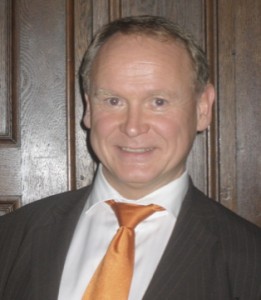 Children know an excellent trick against fear: magic. Their magicians are true works of art. They create illusions nobody feels compelled to adapt to reality.
Children know an excellent trick against fear: magic. Their magicians are true works of art. They create illusions nobody feels compelled to adapt to reality.
During Harry Potter’s third year at the school of witchcraft, we learn how magic dissolves fear. The dangerous magician Sirius Black has escaped from Askaban prison. Now he is looking for Harry Potter, most likely in order to kill him, because allegedly it was him who killed Harry’s parents. Meanwhile, the apprentices of magic learn how to protect themselves against a strong enemy.
Consequently, one lesson starts with the question: “What is a ghost light?”, to which the industrious Hermione replies wisely: “Ghost lights are illusionary figures. They take the form of what the spectator fears most.”
Here we find the insight that the object of fear is based in the subject itself. Unfortunately, cultural history of fear reveals that grown-ups often forget this truth. Instead, they take fear for a real evil. Adults always consider the other party evil, never themselves. Fighting evil, they are oblivious to the fact that their fear of evil is basically a fear of their own subconscious emotions.
That is why the Pope considers it a fundamental task of the Catholic Church to fight the devil. He no longer remembers that what you fear is a projection of your own, subjective experience. Therefore, the Pius brotherhood – who enjoy high standing with the Pope – have no more love for Harry Potter than for the devil. In fact, they even spread fear of Harry Potter.
Harry Potter is far ahead of the Pius brotherhood in that he recognizes that fear can mislead people like a ghost light. Adolescents and children strive to overcome these projections. Harry Potter’s professor advises: “In order to get rid of the ghost lights, you have to say a magic word. The magic word is: ‘Ridiculus’. You have to make them look ridiculous. What used to be unbearable turns into a comic figure.“
Eventually, the Hogwarts professor congratulates Harry Potter when he successfully defends himself. He realizes that the hero of the story has already reached the highest possible understanding of fear: “You are wise. What you fear most is fear itself”. Magic words and jokes are the best defence against the projection fear. If in the adult world magic words have lost their efficiency, there are still jokes.
It is, above all, part of the life style of young people that they prefer to consume those comics in which a mixture of child and superman can supplement by phantasm what real life does not provide for adolescents. Harry Potter’s friends no longer want to be children, yet they are not yet taken seriously by the adults. In this intermediary world, they often idolize “ghost lights”, but they outgrow their own illusions naturally. Every generation has its own would-bees.
What is Bart Simpson today used to be Roadrunner: some sort of road cockatoo who, through his ingenuity, but also sometimes by a certain amount of clownishness always manages not to get caught. The only one who beats him when it comes to ingenuity and clownishness is his enemy, Coyote himself. In real life, he would actually be the victim, but in the cartoon he creates masterful scenes out of the wish of the hunted to be the hunter himself. The noise of a motor cycle alone – cyclists lovingly call it “sound” – can take away the strain generated by a new work contract from the frustrated driver. Werner found the right term for it: “Party time – party on”.
We call Werner, Harry Potter, Pipi Langstrumpf, the Roadrunner and Bart Simpson “trickster“. Basically, he is a weakling and loser, but the potential for auto-suggestion he sets free is enormous. In the wide area of cartoons and comics, we meet him in the shape of Alfred E. Neumann, the hero of the American satirist magazine MAD, who has been questioning every atrocity by laconically asking “so what?” since 1952.
Each society has its tricksters who turn the fear of powerlessness into the hilarity of a heroic success. Asterix and his Gallic friends in their playful fight against the Roman empire; the American suburban Peanuts around the hero Charly Brown, all of whom take life into their own hands and make small things (peanuts) out of great matters; Tarzan, the Flintstones and the Simpsons – they all represent the disarmed craving for power made harmless by beating the common daily dangers by bursts of laughter.
In his epochal work “Thinking Wild”, the anthropologist Claude Lévi-Strauss gave these projections of one’s own fears and symbols for overcoming fear the name „Bricoleur“ (amateur, tinker, hobbyist).. As opposed to the engineer, the Bricoleur is a hobbyist who stands up against the technically educated and well-equipped specialists without suitable tools. He is an excellent improviser, which enables him to constantly challenge the establishment with its fixed orders with his creativity. His final success is by no means a foregone conclusion. He often fails. But the common soul supports him when he dies as a hero, even after having proven to be an irresponsible daredevil by challenging the role of those who wield the power in hopeless manoeuvres.
The typical trickster minimizes a fear built up by a powerful reality by simply denying it. Sometimes, like in many comics, the trickster imitates the object of his fear just like the magic works in Harry Potter, thereby exposing it to ridicule. Grown-ups often only know one answer to this kind of behaviour: forbidding it. Caricatures exposing the projections of fear to ridicule are likely candidates for a ban. Incidentally, in a world where fear is heightened immeasurably, what we need is more caricatures of this kind. Wrack your brains for new caricatures!
KJG
(translated by EG)
